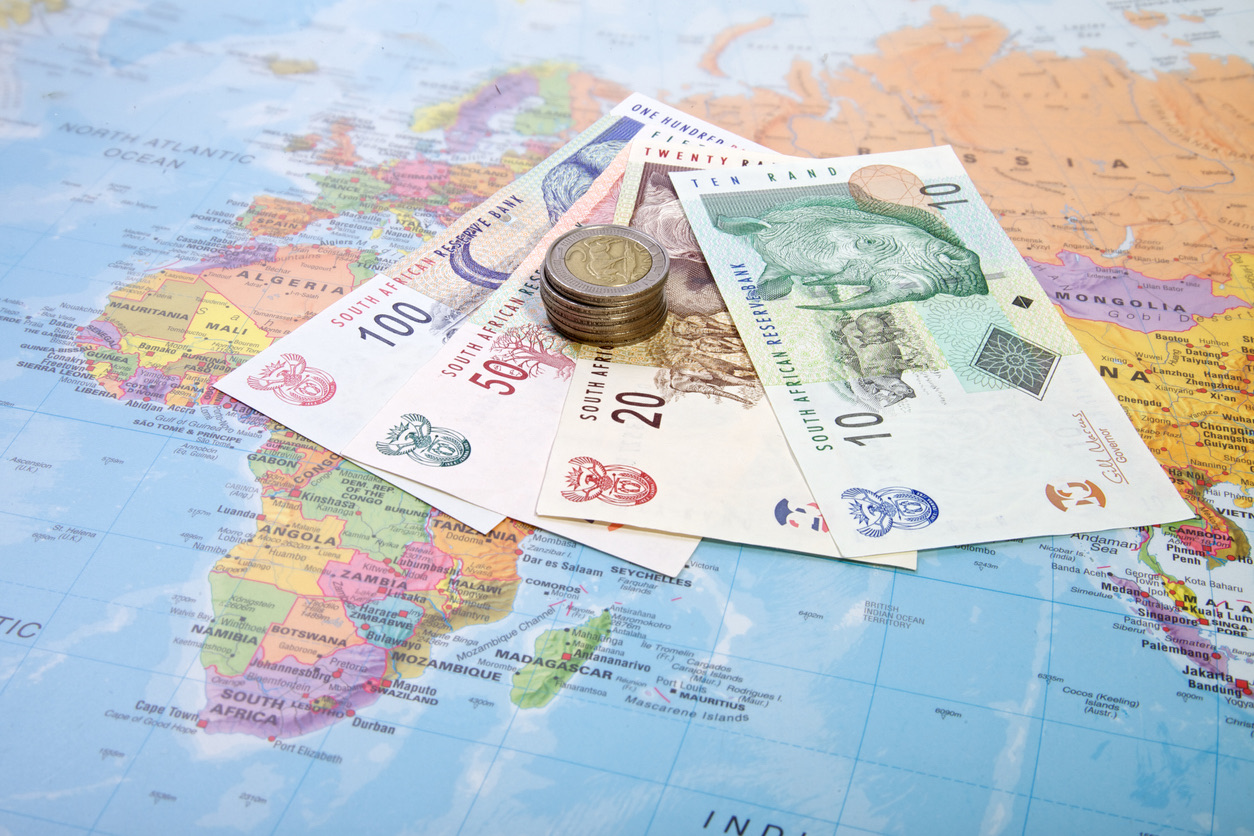
SA rand gained: Analyst says it had looked undervalued
Reuters: The South African rand gained strongly on Tuesday, with one analyst saying it had looked undervalued after year-to-date losses and citing support from rising prices for precious metals, a key South African export. SOUTH AFRICAN RAND GAINED At 1550 GMT, the rand traded at 17.8550 against the dollar, about 1% stronger than its previous […]

Reuters: The South African rand gained strongly on Tuesday, with one analyst saying it had looked undervalued after year-to-date losses and citing support from rising prices for precious metals, a key South African export.
SOUTH AFRICAN RAND GAINED
At 1550 GMT, the rand traded at 17.8550 against the dollar, about 1% stronger than its previous close. Danny Greeff, a financial market analyst at ETM Analytics, said sentiment towards emerging markets had been lifted by softer-than-expected U.S. retail sales. “The rand is outperforming, however, owing to its stretched undervaluation after a dismal year-to-date performance. All the while, gold, platinum, and palladium markets have also seen healthy gains today, providing further support,” Greeff said.
Major local economic data points this week that could influence rand trading are local inflation data out on Wednesday and an interest rate announcement on Thursday. Analysts polled by Reuters are predicting inflation to further decline to 5.6% in June from 6.3% in May, putting it back within the central bank’s 3% to 6% target range for the first time since April 2022. The majority of economists expect no change in the South African Reserve Bank repo rate on Thursday, but a significant minority are predicting a further 25 basis points increase to 8.50%.
ALSO READ: Rand Report: Rand recovers as market sentiment shifts
The SARB has raised rates at its last 10 monetary policy meetings to try to bring inflation back to target, in a hiking cycle that started in November 2021. “Although the market has been paring bets on an extended rate-hike cycle in SA, there is still a strong chance that the SARB hikes by 25 bps to keep the rand on the front foot,” Greeff said. The Johannesburg Stock Exchange’s All-share index closed down 0.2% on Tuesday. South Africa’s benchmark 2030 government bond was firmer, as the yield fell 12 basis points to 10.325%.
U.S. DOLLAR
Reuters: The dollar held just above an over one-year low on Wednesday as traders assessed the U.S. rate outlook, while the New Zealand dollar spiked briefly after a higher-than-expected inflation reading pushed back prospects of policy easing further out. The U.S. dollar managed to nudge up after a mixed retail sales report overnight, with sales growth missing forecasts in June but consumers boosted or maintained spending elsewhere, pointing to consumer resilience that is likely to keep the economy on a solid growth path. Against a basket of currencies, the U.S. dollar rebounded from a 15-month low hit in the previous session, with its index steadying at 99.943 in early Asia trade. “The data showed retail sales being resilient, and I think that’s because the U.S. wage growth is still strong,” said Tina Teng, market analyst at CMC Markets.
The greenback has paused its steep decline from last week in the wake of a cooler-than-expected U.S. inflation reading that led to traders pricing in an imminent peak in U.S. rates. Economists polled by Reuters expect the Federal Reserve to deliver a 25-basis-point rate hike at its upcoming policy meeting this month, with a majority betting that to bring an end to the central bank’s current monetary tightening cycle. Across the Atlantic, European Central Bank ECB policymakers are also adopting a more dovish tone on the rate outlook, with governing council member Klaas Knot saying in an interview on Tuesday that the ECB will look closely for signs of inflation cooling down in the coming months to avoid overly tightening policy.
ALSO READ: Madiba echoed a reality
The euro was last steady at $1.1230, away from the previous session’s 17-month peak of $1.1276. Sterling bought $1.3035, ahead of UK inflation data due later on Wednesday. “The stickiness of UK inflation measures has contrasted notably with price measures in both the euro zone and the U.S. which have been moving lower,” said Rabobank’s head of FX strategy Jane Foley. “If the UK economy remains resilient, we expect that the pound is likely to react well to hawkish expectations regarding Bank of England policy. “However, if recession risks rise in the UK, the pound may revert to pushing lower on rate rises as investors take fright on the overall UK economic backdrop and cut back their long pound positions.”
Over in New Zealand, consumer inflation came in slightly above expectations in the second quarter, data out on Wednesday showed, causing a brief spike in the kiwi as traders pushed out expectations for when the Reserve Bank of New Zealand might start cutting its cash rate. It was last 0.25% higher at $0.6291, after jumping more than 0.6% to a session high of $0.6315 following the release. “While inflation is ‘lower’, it is not ‘low’ by any stretch of the imagination. Importantly, measures of core inflation are continuing to run at rates of around 6%, and some have actually picked up in the June quarter,” said Satish Ranchhod, senior economist at Westpac in New Zealand. “That points to lingering strength in underlying price pressures.”
ALSO READ: Who is the richest person in the world today? Top 10 list – 19 July 2023
The Australian dollar was last 0.08% lower at $0.68065. Elsewhere, the Japanese yen fell marginally to 138.88 per dollar. Bank of Japan Governor Kazuo Ueda said on Tuesday there was still some distance to sustainably and stably achieving the central bank’s 2% inflation target, signalling his resolve to maintain ultra-loose monetary policy for the time being.
BRITISH POUND
Reuters: The pound held steady above $1.30 on Tuesday, around its highest in 15 months, a day ahead of crucial British inflation data that will shape expectations for Bank of England policy, and hence the currency, in the coming months. Sterling was last at $1.3090, up 0.12% on the day, and was also a fraction stronger against the euro, which traded at 85.86 pence. The British currency reached as high as $1.3144 last week, its highest since April 2022, in the wake of data that showed inflation is cooling in the United States.
That caused markets to reduce bets of additional U.S. rate hikes after this month’s U.S. Federal Reserve meeting, and the dollar to soften across the board. Early last week the pound also firmed to as much as 85.05 pence per euro, its strongest since August 2022. British inflation has remained much higher than in the United States – and to a lesser degree the euro zone – and as a result markets expect more rate rises from the BoE, which surprised traders with a 50 basis point rate increase in June.
ALSO READ: Drug Bust: R1,2m worth of drugs seized from Durban beachfront flat
Higher rates are typically a boost for a currency in the near term, though many analysts say the resulting hit to economic growth will weigh on the pound in the long run. “We are observing some positioning ahead of tomorrow’s key release of the UK inflation numbers,” said Francesco Pesole, FX strategist at ING, adding the “CPI data will make or break a 50bp August rate hike by the Bank of England.” “Today, the UK calendar is empty. We suspect EUR/GBP can remain broadly supported into tomorrow’s CPI,” Pesole added.
GLOBAL MARKETS
Reuters: Asia’s stock markets were mixed on Wednesday with growth concerns dragging on China’s equities while shares gained in Japan and Australia after healthy U.S. company earnings and retail data added to hopes that a recession there can be avoided. Dovish remarks from a European Central Bank policymaker boosted bonds and dragged the euro lower. Hotter-than-expected inflation lifted the New Zealand dollar a little and stoked some market nerves ahead of British CPI due later in the day. MSCI’s broadest index of Asia-Pacific shares outside Japan fell 0.3%, with a 1.3% drop in Hong Kong offseting gains of 0.6% in Australia and 0.1% in South Korea. Japan’s Nikkei rose more than 1% to touch a two-week peak. Overnight the S&P 500 rose 0.7% to hit a three-month high, with results propelling bank shares. Futures were flat in Asia.
Headline U.S. retail sales data came in below forecasts, but core sales which exclude food, fuel and building materials, rose a solid 0.6% in June and had economists lifting GDP forecasts. “You can sense the probability of a soft landing,” said Tapas Strickland, head of market economics at National Australia Bank in Sydney. “Core inflation is coming down and there’s momentum from the consumer.” The Atlanta Fed’s influential GDP Now tracker has the U.S economy growing an annualised 2.4% in the second quarter, slightly higher than it’s prediction of 2.3% a week earlier. Morgan Stanley, Bank of America and Bank of New York Mellon shares rose sharply on strong results and an upbeat outlook overnight. Microsoft shares rose 4% – adding $100 billion in market value – after announcing charges for artificial intelligence features in its office software.
ALSO READ: Fuel price UPDATE: No good petrol and diesel news for August 2023
Soft Chinese growth data on Monday and the lack of any urgent policy response kept the mood dreary in Hong Kong, where consumer focussed stocks led losses. A rally in Europe led global bond markets after ECB governing council member Klaas Knot said hikes beyond next week’s meeting were “by no means a certainty.” “That the language stemmed from an often-hawkish voice certainly turned heads and drove European sovereign debt markets stronger and lower in yield,” said Brian Daingerfield, head of G10 currency research at NatWest Markets in New York. Two-year German bund yields fell almost 8 basis points to 3.177%. Benchmark 10-year U.S. Treasuries fell slightly and were steady at 3.7794% on Wednesday. That knocked euro from 17-month highs and its gains stopped sliding dollar in its tracks. The common currency was at $1.2245 in the Asia session.
The yen slipped a fraction to 139.11 per dollar and Japanese government bonds rallied following with the Bank of Japan’s governor sticking to his script that policy shifts are still some time away. The Fed, ECB and BOJ all meet next week. British inflation data due at 0600 GMT is the next major calendar item and traders are expecting a fall to a still-uncomfortable 8.2% annual pace. Surprises on the upside – which occurred in New Zealand – could unwind Tuesday’s gilt rally if it looks like forcing the Bank of England to hike further.
New Zealand inflation came in at 6% year-on-year, which was a slowdown from a reading of 6.7% a month earlier, but drove up the kiwi and two-year swap rates as markets price in rates staying higher for longer. “All up, these data show that risks to the inflation outlook remain firmly to the upside,” said analysts at ANZ. “While annual headline inflation fell sharply, which is helpful for inflation expectations, the details suggest persistence in non-tradables inflation.” Brent crude oil futures were steady at $79.64 a barrel after gaining overnight. Gold , which pays no income, held gains made as yields fell and bought $1,975 an ounce.
ALSO READ: South Africa’s Ramaphosa says arresting Putin declares war
Published by the Mercury Team on 19 July 2023
